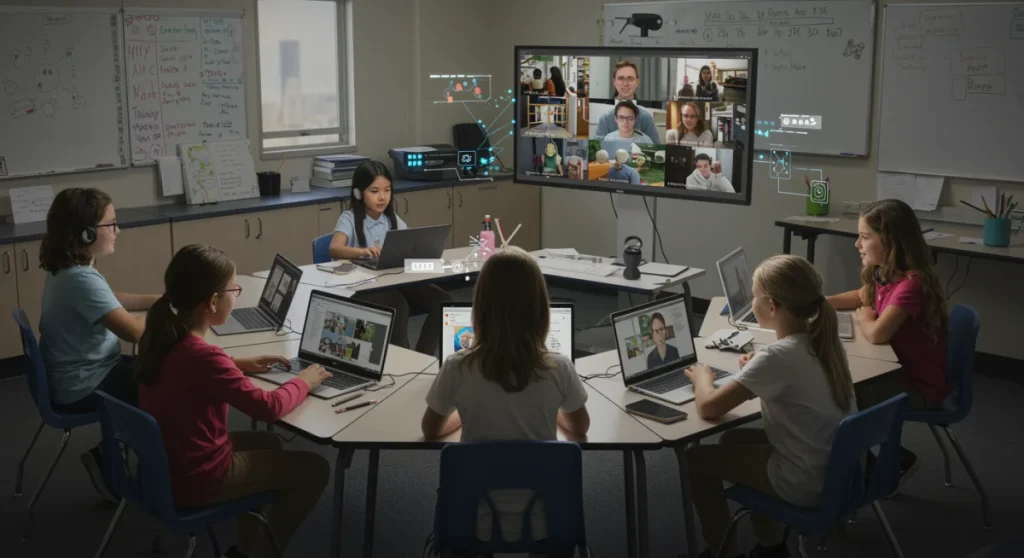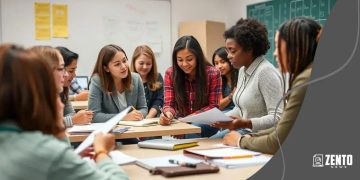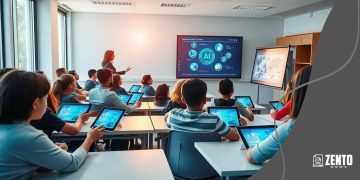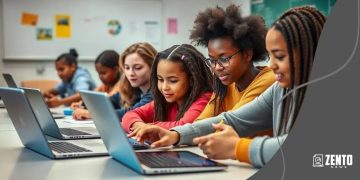Boost Student Engagement in Virtual Classrooms: 7 Techniques

Anúncios
Boosting student engagement in virtual classrooms requires innovative strategies that leverage technology and pedagogical best practices to create interactive and motivating online learning experiences for U.S. students.
Anúncios
As we look towards 2025, the landscape of education continues to evolve, making boosting student engagement in virtual classrooms a paramount concern for U.S. teachers. This shift demands more than just translating traditional methods online; it calls for inventive approaches that captivate students and foster genuine participation in digital learning environments. How can educators effectively harness technology to create dynamic and interactive virtual spaces?
Leveraging Interactive Platforms and Gamification
Interactive platforms and gamification are transforming virtual learning by making it more dynamic and enjoyable. These tools move beyond passive content consumption, encouraging students to actively participate and engage with the material in meaningful ways. By integrating game-like elements, teachers can tap into students’ natural competitive spirit and desire for achievement, making learning feel less like a chore and more like an adventure.
Anúncios
Choosing the Right Tools for Engagement
Selecting appropriate interactive platforms is crucial for success. Not all tools are created equal, and the best ones offer a blend of features that cater to diverse learning styles and subject matters. Teachers should explore options that allow for real-time collaboration, immediate feedback, and personalized learning paths.
- Nearpod and Pear Deck: These platforms allow teachers to embed interactive questions, polls, and activities directly into presentations, ensuring students are actively processing information rather than just listening.
- Kahoot! and Quizizz: Excellent for formative assessments, these gamified quiz platforms turn review sessions into exciting competitions, providing instant feedback and fostering a fun learning atmosphere.
- Minecraft: Education Edition: For project-based learning, this platform allows students to collaboratively build and explore virtual worlds, developing problem-solving skills and creativity in a highly engaging environment.
Gamification extends beyond simple quizzes. It involves designing learning experiences with elements such as points, badges, leaderboards, and narratives. These elements can motivate students by providing clear progress indicators and rewarding effort and achievement. A well-designed gamified lesson can transform abstract concepts into tangible goals, making the learning journey more compelling.
Designing Gamified Learning Experiences
Effective gamification requires careful planning. Teachers need to define clear learning objectives and then integrate game mechanics that align with those objectives. This might involve creating a storyline for a unit, assigning roles to students, or setting up challenges that require critical thinking and collaboration.
- Challenge-Based Learning: Presenting learning objectives as challenges that students must overcome, often in teams, can significantly boost engagement and foster collaborative problem-solving.
- Personalized Progress Tracking: Allowing students to visualize their progress through a learning journey, perhaps with digital badges or level-ups, can be a powerful motivator.
- Narrative Integration: Weaving a story into the curriculum can make content more memorable and emotionally resonant, keeping students invested in the learning process.
By thoughtfully integrating interactive platforms and gamification, U.S. teachers can create virtual classrooms that are not only educational but also inherently engaging, encouraging students to become active participants in their own learning journey. This approach not only boosts academic performance but also fosters a love for learning that extends beyond the virtual screen.
Fostering Collaborative Learning Environments
Creating opportunities for collaboration in virtual settings is essential for boosting student engagement. When students work together, they learn from each other, develop critical social skills, and feel a stronger sense of community within the classroom. Virtual tools can facilitate these interactions, making group work as effective, if not more so, than in a traditional classroom.
Tools for Seamless Virtual Collaboration
The right digital tools can make collaborative tasks efficient and enjoyable. These tools should allow for real-time interaction, document sharing, and clear communication channels, mimicking the feel of in-person group work.
- Google Workspace (Docs, Slides, Jamboard): These tools enable real-time co-editing and brainstorming, allowing students to work on shared projects simultaneously and see each other’s contributions instantly.
- Microsoft Teams and Zoom Breakout Rooms: Ideal for small group discussions and project work, breakout rooms provide a private space for students to collaborate, with teachers able to drop in and offer support.
- Miro and Mural: Virtual whiteboards offer an expansive canvas for brainstorming, diagramming, and organizing ideas collaboratively, perfect for visual learners and complex projects.
Effective collaboration also involves clear expectations and structured activities. Teachers should provide explicit instructions for group tasks, assign roles within groups, and establish clear deadlines. This structure helps prevent common pitfalls of group work, such as unequal participation or confusion about objectives.
Designing Engaging Group Activities
Beyond simply assigning group projects, teachers can design specific activities that maximize collaborative learning. These activities should encourage active participation from all members and require students to synthesize information and communicate effectively.
- Jigsaw Method: Students become experts on a specific part of a topic and then teach their findings to their group members, ensuring everyone contributes and learns from their peers.
- Peer Review Sessions: Students provide constructive feedback on each other’s work, developing critical analysis skills and improving their own output based on peer insights.
- Virtual Debates and Discussions: Structured online discussions or debates using video conferencing tools can foster critical thinking and communication skills, allowing students to engage with diverse perspectives.
By intentionally designing and facilitating collaborative learning environments, U.S. teachers can transform virtual classrooms into dynamic spaces where students actively construct knowledge together, fostering deeper understanding and a stronger sense of belonging. This approach is vital for maintaining high levels of engagement in the digital age.
Personalized Learning Paths and Adaptive Technologies
Personalized learning is a powerful strategy for boosting student engagement in virtual classrooms. Recognizing that each student has unique needs, strengths, and learning paces, adaptive technologies can tailor content and activities to individual learners. This approach ensures that students are challenged appropriately, preventing boredom for advanced learners and frustration for those who need more support.
Harnessing Adaptive Learning Platforms
Adaptive learning platforms use algorithms to adjust the learning experience in real-time based on student performance. They identify gaps in understanding and provide targeted resources, ensuring that every student receives the instruction they need to succeed.
- DreamBox Learning and ST Math: These platforms offer personalized math instruction, adapting to each student’s pace and providing individualized pathways through the curriculum.
- Lexia Core5 Reading and i-Ready: For literacy development, these tools assess student proficiency and deliver customized lessons and activities to build reading and language skills.
- Khan Academy: While not strictly adaptive in all its features, Khan Academy offers personalized dashboards and practice exercises that allow students to learn at their own pace and focus on areas where they need improvement.
The beauty of adaptive technologies lies in their ability to provide immediate feedback and adjust difficulty levels dynamically. This constant responsiveness keeps students engaged because they are always working within their zone of proximal development, feeling neither overwhelmed nor unchallenged. It also empowers students to take ownership of their learning journey.
Implementing Differentiated Instruction Virtually
Even without fully adaptive platforms, teachers can implement differentiated instruction in virtual classrooms. This involves offering various ways for students to access content, process information, and demonstrate their learning, catering to diverse learning styles and readiness levels.
- Multiple Content Formats: Provide information through videos, audio clips, written texts, and interactive simulations to accommodate different preferences.
- Tiered Assignments: Offer assignments with varying levels of complexity or support, allowing students to choose tasks that best match their current understanding.
- Flexible Pacing: While maintaining deadlines, allow some flexibility for students to work through modules at a pace that suits them, especially for asynchronous activities.
By embracing personalized learning paths and adaptive technologies, U.S. teachers can create virtual environments where every student feels seen, supported, and motivated. This individualized approach not only enhances engagement but also leads to more equitable and effective learning outcomes across the diverse student population.
Integrating Multimedia and Visual Storytelling
In a world saturated with digital content, integrating multimedia and visual storytelling into virtual classrooms is crucial for capturing and maintaining student attention. Static lectures and text-heavy presentations can quickly lead to disengagement. By contrast, rich visual and auditory elements can make complex topics more accessible, memorable, and enjoyable.
Enhancing Content with Diverse Media
Moving beyond traditional text and images, teachers can incorporate a variety of multimedia formats to cater to different learning styles and keep the learning experience fresh and dynamic. This approach makes content more digestible and engaging.
- Interactive Videos: Use tools that allow for embedded questions, quizzes, and clickable elements within videos (e.g., Edpuzzle, PlayPosit), transforming passive viewing into active learning.
- Infographics and Visual Summaries: Condense complex information into easily understandable visual formats, which are highly effective for conveying data and relationships quickly.
- Podcasts and Audio Clips: Offer audio-based content for auditory learners or for review purposes, allowing students to engage with material while doing other activities.
Visual storytelling takes multimedia integration a step further by weaving narratives around educational content. Stories are inherently engaging and help students connect emotionally with the material, making it more relevant and memorable. This can be particularly effective for subjects like history, literature, and even science.
Crafting Compelling Visual Narratives
Teachers can become storytellers, using visual aids to build compelling narratives that make learning an immersive experience. This involves more than just showing pictures; it’s about guiding students through a visual journey of discovery.
- Digital Storytelling Projects: Assign students to create their own digital stories using tools like Book Creator or Adobe Spark, encouraging them to research, synthesize, and present information creatively.
- Virtual Field Trips: Utilize 360-degree videos and virtual reality tours to transport students to historical sites, museums, or even remote ecosystems, providing immersive experiences that traditional classrooms cannot.
- Interactive Simulations: Employ simulations (e.g., PhET Interactive Simulations for science and math) that allow students to manipulate variables and observe outcomes, making abstract concepts tangible and fostering inquiry-based learning.
By thoughtfully integrating multimedia and visual storytelling, U.S. teachers can transform virtual classrooms into vibrant, engaging spaces that appeal to modern learners. This approach not only enhances understanding but also cultivates creativity and a deeper appreciation for the subject matter, significantly boosting student engagement.
Implementing Project-Based Learning (PBL)
Project-Based Learning (PBL) is an incredibly effective strategy for boosting student engagement in virtual classrooms, particularly when students are learning remotely. PBL allows students to delve into real-world problems and challenges, fostering critical thinking, collaboration, and creativity. This approach shifts the focus from rote memorization to application and inquiry, making learning more relevant and motivating.
Designing Meaningful Virtual PBL Projects
Successful PBL in a virtual environment requires careful planning and the use of appropriate digital tools. Projects should be structured to encourage independence while also providing opportunities for peer interaction and teacher guidance. The key is to present students with authentic problems that resonate with their interests and experiences.
- Define Clear Outcomes: Establish clear learning objectives and expected deliverables for the project from the outset, ensuring students understand the purpose and scope.
- Provide Scaffolding: Break down complex projects into manageable phases with clear checkpoints and resources, particularly important in a virtual setting where direct oversight is limited.
- Integrate Technology: Leverage various digital tools for research, collaboration, creation, and presentation, allowing students to explore different modalities for demonstrating their learning.
PBL projects often culminate in a public presentation or a shareable product, which adds an element of authenticity and purpose. Knowing their work will be seen by others motivates students to produce high-quality results. In a virtual context, this could involve creating websites, digital portfolios, video documentaries, or online presentations.
Examples of Virtual PBL in Action
Teachers can adapt a wide range of real-world scenarios into engaging virtual PBL projects. These projects encourage students to apply knowledge, solve problems, and develop essential 21st-century skills.
- Community Improvement Project: Students research a local issue (e.g., environmental concern, social equity) and propose digital solutions, creating presentations or websites to advocate for their ideas.
- Entrepreneurial Challenge: Students develop a business plan for a new product or service, including market research, financial projections, and a virtual pitch to their classmates or a panel.
- Historical Reenactment/Documentary: Students research a historical event or figure and create a digital reenactment, podcast series, or short documentary, bringing history to life through their own interpretations.

By implementing Project-Based Learning, U.S. teachers can transform passive virtual learners into active investigators and creators. This methodology not only significantly boosts student engagement by making learning relevant and hands-on but also equips students with valuable skills for future academic and professional success.
Utilizing Virtual Reality (VR) and Augmented Reality (AR)
The immersive capabilities of Virtual Reality (VR) and Augmented Reality (AR) offer unparalleled opportunities for boosting student engagement in virtual classrooms. These technologies transcend traditional screen-based learning, allowing students to experience content in a three-dimensional, interactive environment. By bringing abstract concepts to life and enabling virtual exploration, VR and AR can make learning unforgettable and deeply impactful.
Exploring Educational VR/AR Applications
While often perceived as futuristic, numerous accessible VR and AR applications are already available for educational use. These tools can transport students to places and situations that would otherwise be impossible to experience, making learning highly experiential.
- Virtual Field Trips: Applications like Google Expeditions (or similar successors) allow students to virtually visit historical landmarks, distant countries, or even the surface of Mars, providing rich contextual learning without leaving the classroom or home.
- Anatomy and Biology Simulations: VR/AR apps can provide interactive 3D models of the human body, animals, or plant cells, enabling students to dissect, explore, and understand complex biological systems in a hands-on manner.
- Historical Recreations: Students can step into historical events, walking through ancient Rome or witnessing key moments in history, fostering a deeper understanding and empathy for past eras.
The power of VR and AR lies in their ability to make learning tangible and emotionally resonant. When students can physically interact with virtual objects or navigate simulated environments, their level of engagement and retention dramatically increases. This is particularly valuable for complex subjects that benefit from visual and spatial understanding.
Integrating VR/AR into Curriculum
Implementing VR and AR doesn’t necessarily require extensive equipment. Many AR experiences can be accessed via smartphones or tablets, making them more feasible for widespread adoption. Teachers should identify specific learning objectives that can be significantly enhanced by these immersive technologies.
- Science Experiments: Use AR to overlay virtual elements onto real-world objects, allowing students to conduct virtual experiments or visualize scientific phenomena in their own homes.
- Language Learning: VR environments can simulate real-life scenarios (e.g., ordering food in a restaurant, navigating a foreign city) for immersive language practice, building confidence and fluency.
- Art and Design: Students can use VR tools to sculpt, paint, or design in 3D, fostering creativity and spatial reasoning in a new medium.
By strategically integrating Virtual Reality and Augmented Reality, U.S. teachers can provide students with truly innovative and engaging learning experiences. These technologies not only boost engagement by making learning exciting and interactive but also prepare students for a future where immersive digital environments will be increasingly commonplace, fostering essential digital literacy skills.
Encouraging Student Voice and Choice
Empowering students with voice and choice is a fundamental strategy for boosting engagement, especially in virtual classrooms where feelings of isolation can sometimes arise. When students have a say in their learning, they become more invested, motivated, and responsible for their educational journey. This approach acknowledges their autonomy and respects their individual learning preferences.
Providing Options for Content and Expression
Offering choices in how students learn and demonstrate their understanding can significantly increase their buy-in. This moves away from a one-size-fits-all approach, recognizing that different students thrive under different conditions and express themselves in various ways.
- Flexible Assignment Formats: Instead of only written essays, allow students to create videos, podcasts, infographics, or digital presentations to showcase their knowledge.
- Choice Boards or Learning Menus: Provide a selection of activities or resources related to a topic, allowing students to choose which ones best suit their interests or learning style.
- Topic Selection: Whenever possible, give students the opportunity to choose specific sub-topics or areas of inquiry within a broader unit, fostering a sense of ownership over their learning.
Student voice also extends to allowing them to provide feedback on the learning process itself. Regularly soliciting input on what’s working, what’s challenging, and what could be improved helps teachers adapt their virtual instruction to better meet student needs. This creates a more dynamic and responsive learning environment.
Fostering Student-Led Initiatives
Beyond individual choices, encouraging student-led initiatives can build a strong sense of community and collective ownership within the virtual classroom. When students lead, they develop leadership, organizational, and communication skills.
- Student-Led Discussions: Empower students to facilitate online discussions or lead small group activities, with the teacher acting as a facilitator rather than the sole authority.
- Peer Tutoring Programs: Establish virtual peer tutoring, where students can help each other with challenging concepts, reinforcing their own understanding while supporting their classmates.
- Classroom Norms and Rules: Involve students in co-creating virtual classroom norms, fostering a sense of responsibility and mutual respect for the learning environment.
By prioritizing student voice and choice, U.S. teachers can cultivate virtual classrooms where students feel valued, heard, and empowered. This approach not only boosts engagement by increasing intrinsic motivation but also develops essential self-direction and critical thinking skills, preparing students to be lifelong learners and active participants in a democratic society.
| Key Technique | Brief Description |
|---|---|
| Interactive Platforms & Gamification | Uses game-like elements and engaging tools to make learning fun and competitive. |
| Collaborative Environments | Fosters teamwork and peer learning through digital tools and structured group activities. |
| Personalized Learning Paths | Tailors content and pace to individual student needs using adaptive technologies. |
| VR/AR Integration | Provides immersive, 3D experiences for deeper understanding and exploration of concepts. |
Frequently Asked Questions About Virtual Classroom Engagement
The primary challenges include screen fatigue, lack of social interaction, technical difficulties, and maintaining focus without physical presence. Distractions at home and varying access to technology also contribute to difficulties in keeping students consistently engaged in online settings.
To use gamification effectively, align game mechanics directly with learning objectives. Focus on meaningful challenges, clear progress tracking, and rewarding effort. Ensure the ‘game’ elements enhance understanding and skill development, rather than just being a distraction or superficial add-on to the curriculum.
Yes, personalized learning is achievable even with large classes by leveraging adaptive technologies and AI-driven platforms. These tools automate differentiation, allowing teachers to focus on individualized support where it’s most needed. Implementing choice boards and flexible pacing also contributes significantly to personalization.
Teachers can use free tools like YouTube for educational videos, Canva for infographics, and Audacity for simple audio recordings. Screen-recording software can create quick video explanations. Even simple interactive slides with embedded questions can significantly boost multimedia integration without needing expensive software or subscriptions.
In asynchronous settings, provide options for assignment formats, offer choice boards for activities, and allow students to select project topics. Use online discussion forums for student-led conversations and regularly survey students about their learning preferences and challenges to gather valuable feedback and empower their choices.
Conclusion
The journey to boosting student engagement in virtual classrooms by 2025 is an ongoing evolution, requiring U.S. teachers to embrace innovation and adapt their pedagogical approaches. By thoughtfully integrating interactive platforms, fostering collaborative environments, personalizing learning paths, leveraging multimedia, implementing project-based learning, exploring immersive technologies like VR/AR, and empowering student voice and choice, educators can transform online learning from a challenge into an opportunity. These seven techniques are not just trends; they are foundational shifts that promise to create more dynamic, equitable, and ultimately more effective virtual learning experiences for all students, preparing them for a future that is increasingly digital.





